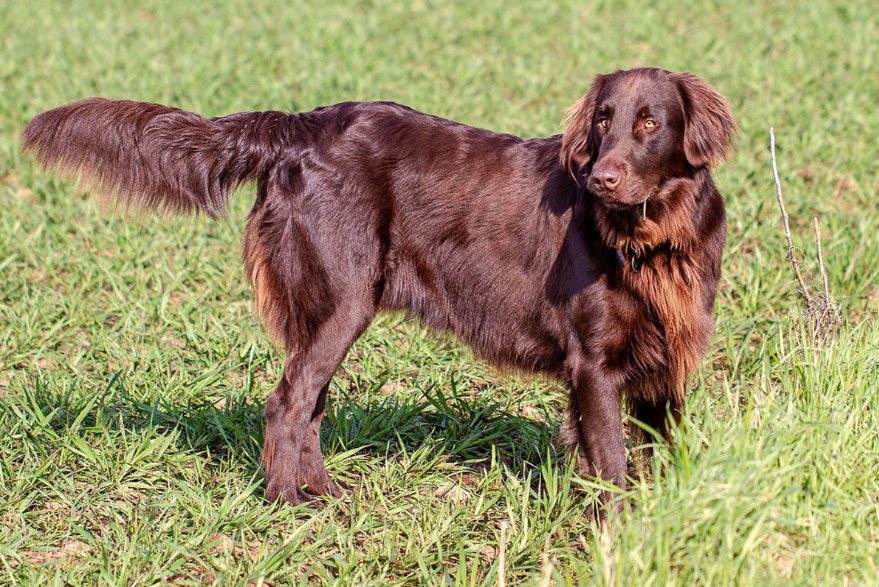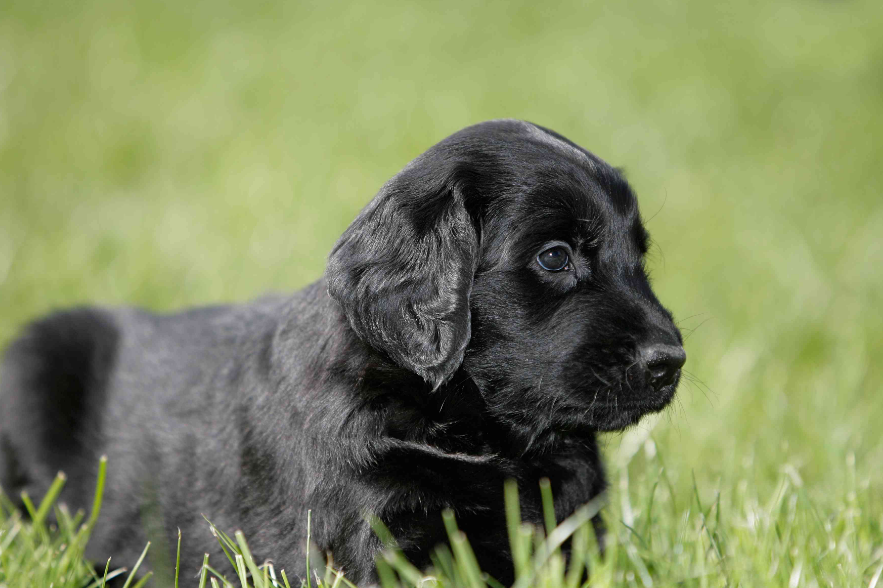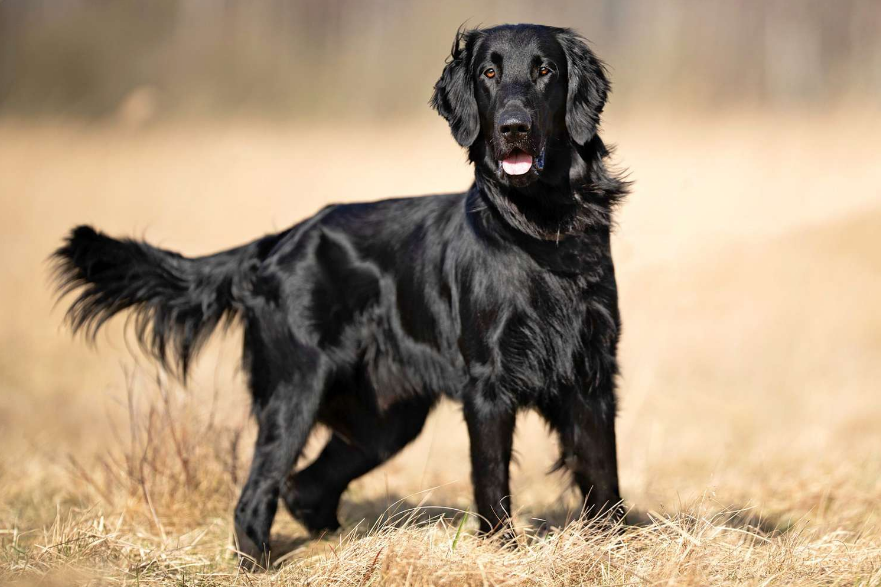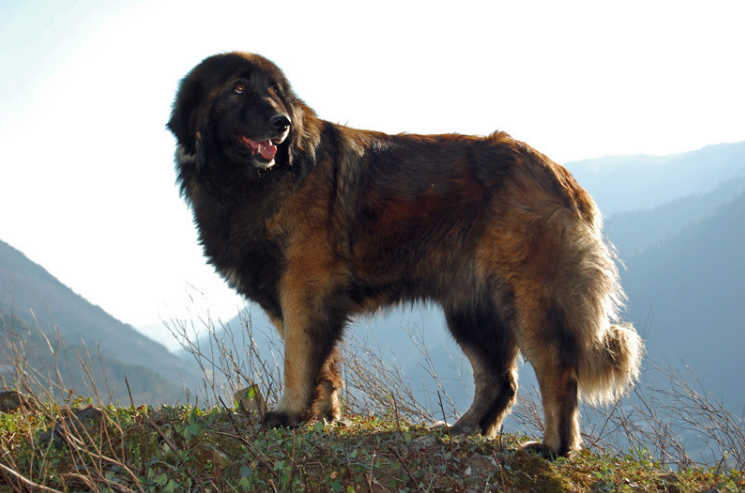Flat-Coated Retriever
A Flat-Coated Retriever is a breed of dog that is renowned for its friendly and lively temperament, as well as its distinctive, long glossy black or a vibrant red coat. They sport a well-balanced and athletic body, sporting sleek, clean cut heads and a slender neck dark eyes, and a brown or black nose. The most distinctive Flat-Coated Retriever characteristic is its long flat-lying, thick waterproof coat. It is either solid black or red-colored. Regular grooming and brushing is vital to maintain the coat’s condition.
Adult males usually stand between 23-24.5 inches around the shoulders While females are slightly smaller. The average Flat-Coated Retriever is in the range of 60 and 70 pounds. They are well-known for their sociable and outgoing personality, which makes them a favorite option for families. They are highly intelligent and trainable, excelling at different dog sports and activities.
Flat-coated retrievers require a regular amount of physical activity, including regular walks, playtime and mental stimulation, in order to keep them fit and healthy. They may be susceptible to certain health issues including hip dysplasia and certain forms of cancer, and retinal atrophy. Regular check-ups with a veterinarian and a balanced diet are crucial to their health.
The life expectancy that a Flat-Coated Retriever can live ranges from between 10 and 12 years. They make great companions for active people as well as families, offering the opportunity for exercise, mental stimulation and love. A proper education and socialization at the age of 5 are essential for their well-behaved, sociable personality.
Flat-Coated Retriever History
The Flat-Coated Retriever, a breed of dog, has a long background that dates back to the early 19th century of England. It was designed to be an agile retrieving dog capable of land and water retrieval. The breed’s history is unclear however the theory is that it may be influenced by a variety of breeds, such as those of the Newfoundland, Labrador Retriever, and even Collies and Setters.
The breed’s development in the beginning had a lot to do with gamekeepers as well as hunters in England and the United Kingdom, who wanted dogs with exceptional ability to retrieve. The early retrievers were referred to in the early days as “Wavy-Coated Retrievers” or “Retrievers of the Newfoundland type.” Breeders crossed them with different breeds in order to increase certain traits, and possibly adding bloodlines of those of the Labrador Retriever and possibly the Collie.
The late 19th century saw the beginning of a new era the breed was stable, and Flat-Coated Retrievers started to appear. They became famous for their remarkable retrieving knowledge and their amiable temperament. But their popularity waned following World War I due to the popularity of the Labrador Retriever and the perception that the Flat-Coated Retriever was slower to grow older.

The effort was started in the late 20th century to revive and encourage the breed. The breed being recognized as a breed in the mid-20th century by The Kennel Club in the United Kingdom in 1923 and the American Kennel Club in 1915. Nowadays it is a popular breed. Flat-Coated Retriever is appreciated for its ability to retrieve, friendliness manner of living, and its ability to be an ideal pet for families.
Flat-Coated Retriever Health
They are typically healthy however, they are susceptible to a variety of health issues. These include hip dysplasia Progressive Retinal Atrophy (PRA) and autoimmune disorders such as heart diseases, ear infections as well as obesity and joint issues.
Cancer is more common within this species, and histiocytic tumors and various kinds of tumors becoming more common. Regular check-ups with your veterinarian along with early identification are vital in addressing these issues. Hip dysplasia is a condition in which the hip joint does not fit into the socket of the hip properly, may result in lameness and arthritis. Progressive Retinal Atrophy (PRA) is a genetic disease which causes gradual loss of the retina. It can lead to blindness.
Autoimmune diseases, in which the immune system is mistakenly attacking tissues of the body, could need ongoing medical care from a vet. Ear infections can be avoided by regular cleaning and examination of the ear. Heart problems, like valve issues can be detected through regular vet check-ups. Obesity, caused by their desire for sweets and food can be controlled with an appropriate diet as well as regular workout. Joint issues, like elbow dysplasia, are diminished through good nutrition, weight management along with controlled workouts.
To warrant the health and well-being of Flat-Coated Retrievers’ owners, they should select breeders with a good reputation who are concerned about their health and carry out pertinent health checks. Regular check-ups with a veterinarian and a balanced diet regular exercise and prompt intervention are vital to ensure the health of the breed.
Flat-Coated Retriever Care
Care for Flat-Coated Retrievers is about satisfying their physical, mental and social requirements. Regular grooming is essential to avoid matting and ensure their overall health. It also involves making sure they clean their ears as required. Fitness is vital for their spirited nature, which is why they should be doing 60-90 minutes of daily physical activity. Training in obedience and socialization is crucial to their growth into a well-behaved adult, with positive reinforcement methods such as sweets and praise.
Socialization should start at an early age, and expose the children to different locations, people and experiences in order to avoid anxiety or shyness. Food must be balanced and appropriate to the nutritional needs of your child, by having regular vet check-ups to check general health and recommend preventive measures to avoid frequent health problems such as hip dysplasia and cancer. It is possible to stimulate your mind through interactive toys, puzzles, games, obedience training or through canine sports.

Flat-Coated Retrievers are renowned for their warm and loving nature. Therefore, it is important to spend moments with them. impart love, as well as assure that they feel safe and appreciated. Security and supervision are vital due to their affectionate nature, particularly when they are in unfamiliar surroundings. A secure fence is essential to stop them from wandering away.
Since every dog is unique and their needs can differ therefore it is important to observe their behaviour and alter your routines of care like to. Regularly scheduled veterinary visits, appropriate food intake, and an cosy surroundings can warrant a comfortable as well-balanced life for your flat-coated retriever.
Flat-Coated Retriever Feeding and Grooming
Feeding:
Select a premium dog food appropriate for your Flat-Coated Retriever’s ages size, size, as well as levels of activity. Stay clear of add-ons or fillers. Divide the daily meal between two meal times to avoid the bloat, and adhere to the recommended guidelines for feeding. Check your dog’s weight regularly to ensure that they are at an appropriate weight and modify their diet and exercise schedule as needed. Make sure to help in providing access to clean and clean water to ensure general well-being. Regular intake of water is crucial for overall health.
Grooming:
Flat-coated retrievers have a thick flat-lying coat, which requires regular brushing in order to prevent matting and to reduce the amount of shed. Make use of a slicker brush or the combination of the slicker brush and combing comb at a minimum of two to three times per week, but more often during the time of shedding. Cleanse your Flat-Coated Retriever whenever necessary, together a mild dog shampoo to avoid irritation of the skin. Be aware of their ears because they are susceptible to infections in the ear. Regularly trim their nails to avoid them becoming too long and creating discomfort. Keep your teeth clean by regularly brushing their teeth and together an animal-friendly toothbrush and toothpaste.
Make sure you invest in high-quality grooming tools including brushes and nail clippers, combs and ear-cleaning solutions to make grooming more relaxing for both you as well as your pet. Professional grooming is required for tasks such as trimming excessive hair or to maintain the overall health of your coat. Examine for bumps, lumps or any other anomalies when grooming and get immediate veterinary care. A regular grooming routine will not only keep the Flat-Coated Retriever at their excellent but can also benefit improve their overall health and well-being.
Flat-Coated Retriever Temperament
Flat-Coated Retrievers can be described as a fun outgoing and lively breed that is known for their friendly nature. They are renowned for their lively and energetic nature, which makes them ideal friends for active individuals as well as families. Flat-coated retrievers are clever as well as trainable. They excel at obedience training as well as other canine activities. They are lively, affectionate and energetic, frequently exploring new things with enthusiasm and enthusiasm.
Although they’re not guard dogs Flat-Coated Retrievers are observant and cautious, greeting strangers with kindness instead of aggression. A healthy socialization program is vital for Flat-Coated Retrievers as exposure to different individuals, places and settings at an early age can help to develop into comfortable and well-behaved adults. They can be a good match with other pets like cats and dogs, which makes them excellent companions for the pets in the home.

Multi-faceted, these dogs can be adapted and versatile and excel in a variety of kinds of activities like obedience tests agility, retrieving games. They typically grow older slower than other breeds of retriever However, their playful and playful personality can last through adulthood, making them appealing and entertaining.
In conclusion Flat-Coated Retrievers can be described as social dogs that is a fantastic companion to an active home. Factors like genetics along with early socialization and even training play an important role in determining a dog’s behaviour. Methods of reinforcement training that are positive and the early exposure to a variety of different environments and people could benefit to bring out the excellent qualities of Flat-Coated Retrievers’ temperament and make them a great option for any home.
Flat-Coated Retriever Lifespan
The lifespan of the Flat-Coated Retriever is between 10 and 12 years, however things like genetics, health eating habits, exercise and veterinary care may affect the lifespan of this breed. To assure the healthiest life for your pet, prepare regular veterinary check-ups as well as a balanced diet regular exercises, and healthy space. Good breeding practices, such as checking for health issues inherited from the family could also aid in the longevity of the breed. Regular dental check-ups as well as preventive measures and weight control can rise the lifespan of the breed. Being aware of your physical, mental and emotional needs, and addressing any health concerns that could arise promptly will improve the quality of life and prolong the life span that the dog breed enjoys. Regular surveillance, early detection and an active method are vital to taking care of this breed.






